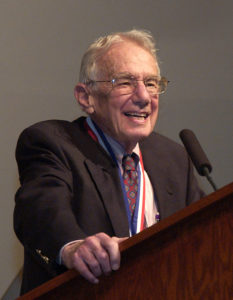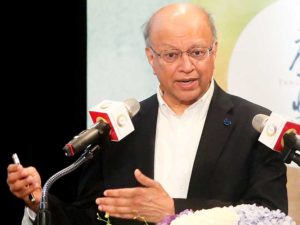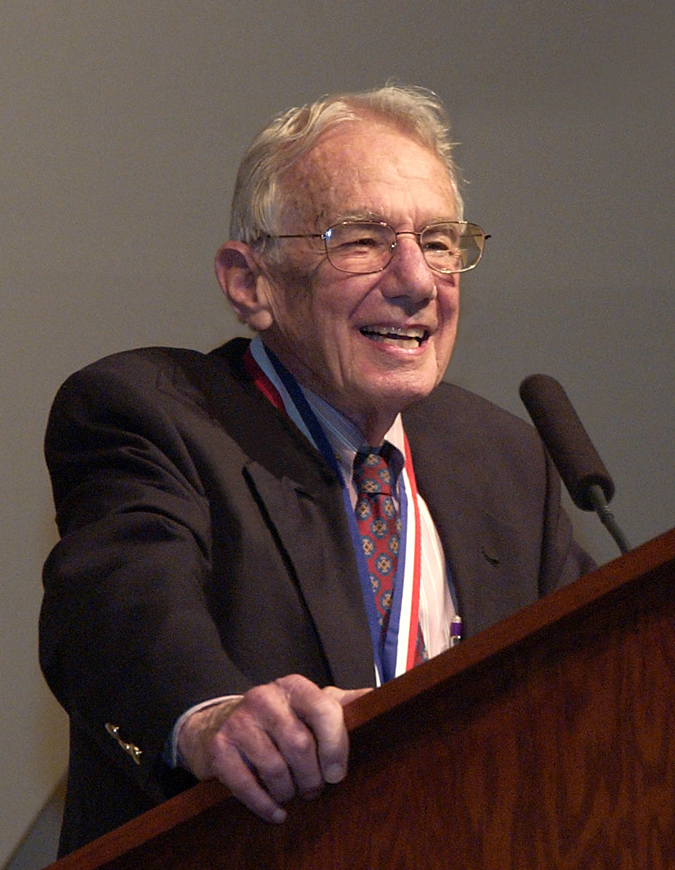-Written by Lynn Yarris
How do you speak on behalf of a living legend like Berkeley Lab’s Art Rosenfeld, a particle physicist who attained international recognition as the “godfather of energy efficiency?” That was the challenge faced by Ashok Gadgil, Science and Technology Deputy for Berkeley Lab’s Energy Technologies Area, on September 25 in Taipei City, Taiwan.

Arthur “Art” Rosenfeld, winner of the 2016 Tang Prize in Sustainable Development (Photo by Roy Kaltschmidt)
This past June, Rosenfeld was awarded the 2016 Tang prize in Sustainable Development for “his lifelong and pioneering innovations in energy efficiency resulting in immense reductions in energy consumption and greenhouse gas emissions around the world.” The Tang prize mirrors the Nobel Prize in the selection process of its Laureates and includes a cash prize of $1.24 million. Winners received their award in Taipei where they were to present a laureate lecture. At the age of 90, Rosenfeld was too frail to make the trip and asked former grad student, longtime colleague, and close friend Gadgil to give the lecture in his place. After what Gadgil describes as “many hours of conversation with Art,” he delivered.
Following an introduction by Yuan Tseh Lee, who won the 1986 Nobel Prize in Chemistry while a scientist at Berkeley Lab, Gadgil, himself a celebrity in the energy sciences for his prize-winning and life-saving research on water purification, cook-stoves and arsenic removal, spoke of his collaborations with Rosenfeld which began in 1975, the year “Art changed the trajectory of his research from particle physics to studies of energy efficiency.”
No one, including Rosenfeld himself, could have foreseen such a trajectory change back in 1954, when he received his Ph.D. in physics from the University of Chicago as the last graduate student of Nobel Laureate Enrico Fermi. The following year he joined the physics group at Berkeley led by another legendary scientist and Nobel Laureate Luis Alvarez. Rosenfeld eventually assumed leadership of the group and played important roles in bubble chamber physics and data analysis. Then came the OPEC oil embargo of 1973 and the realization of how vulnerable the United States had become because of its dependency on foreign energy.

Ashok Gadgil delivering the Tang Prize lecture on behalf of Art Rosenfeld (courtesy of the Tang Prize Foundation)
“The oil crises in the 1970s as well as a rising awareness of global warming and climate change, made it clear to Art that energy was a central problem not just for the United States, but for the sustainable future of humanity as a whole,” Gadgil said. “He started asking questions such as why the lights in San Francisco Bay Area skyscrapers were on 24 hours a day. It turned out there were no on/off-switches for these lights, they were directly wired to circuit breakers.”
Asking the right questions became the key to Rosenfeld’s transition from particle physicist to energy-efficiency champion, Gadgil said.
“Before Art got involved, the standard question asked about energy was how can we supply enough to meet society’s goals,” Gadgil said. “Art reframed the question in a revolutionary way by asking how can we accomplish society’s goals more efficiently and cheaply? This led to an entirely different discussion.”
In 1975, Rosenfeld launched a program at Berkeley Lab to provide answers and solutions to the questions he was asking. This program would evolve into the Center for Building Sciences, which Rosenfeld led until 1994. Under Rosenfeld’s leadership, the Center for Building Sciences racked up a plethora of game-changing accomplishments in energy efficient technologies, including the high-frequency electronic ballasts which made compact florescent lamps possible, low-emissivity and spectrally-selective windows that allow visible light to pass through while reflecting thermal radiation, and Cal-ERDA and DOE-2, computer programs for building energy analysis and design that have been adopted throughout the U.S. and in many other countries as well.
Rosenfeld relinquished leadership of the Center for Building Sciences in 1994 to serve a five year stint as a senior advisor to the U.S. Energy Department on energy efficiency and renewable energy. From 2000 to 2010 he severed as California’s Energy Commissioner, helping to enact residential and commercial energy savings that enabled California’s per-capita electricity use to remain flat while the rest of the country experienced an increase of about 40-percent. This accomplishment is now widely known as the Rosenfeld Effect.
“There is no law of physics and no law of nature that prevents human society from achieving long-term prosperity and sustainable development,” Gadgil said, quoting Rosenfeld. “Our success or failure to do so rests entirely in the choices we make and the actions we take.”
Through the technologies, policies, and innovations promoted by Rosenfeld, including the successively stringent energy-efficiency Federal standards for a slew of energy consuming appliances, a Berkeley Lab study showed that the U.S. had saved $480 billion net in energy costs by 2012, with another $500 billion net savings projected over the next 50 years (in 2012 dollars).
Perhaps even more important for the health of our planet is the reduction in carbon dioxide emissions that have resulted from Rosenfeld’s efforts. As noted by Robert Sawyer, former Chairman of the California Air Resources Board (CARB), the agency charged with ensuring that California meets its extremely aggressive carbon dioxide emission-reduction goals, “No other individual on the planet has saved more carbon dioxide than Art Rosenfeld.”
Did Gadgil meet the challenge of speaking on behalf of Rosenfeld? Upon viewing a recording of the lecture, Rosenfeld told Gadgil, “You did a fantastic job and said what had to be said.”
To watch a YouTube video of Ashok Gadgil’s Tang Lecture go here
For more about Art Rosenfeld’s Tang Prize go here
